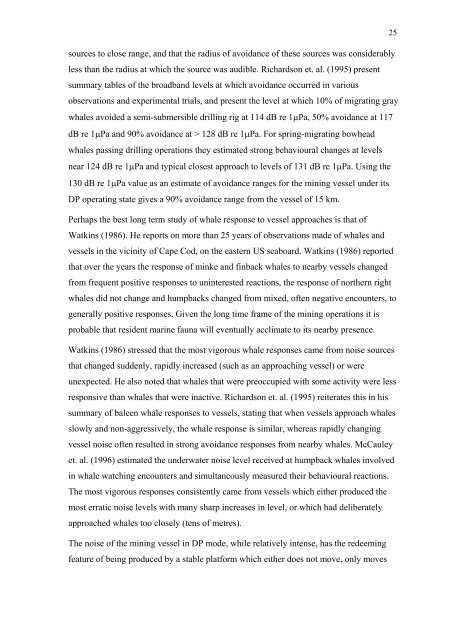Appendices 5-13 - Nautilus Cares - Nautilus Minerals
Appendices 5-13 - Nautilus Cares - Nautilus Minerals
Appendices 5-13 - Nautilus Cares - Nautilus Minerals
You also want an ePaper? Increase the reach of your titles
YUMPU automatically turns print PDFs into web optimized ePapers that Google loves.
sources to close range, and that the radius of avoidance of these sources was considerably<br />
less than the radius at which the source was audible. Richardson et. al. (1995) present<br />
summary tables of the broadband levels at which avoidance occurred in various<br />
observations and experimental trials, and present the level at which 10% of migrating gray<br />
whales avoided a semi-submersible drilling rig at 114 dB re 1"Pa, 50% avoidance at 117<br />
dB re 1"Pa and 90% avoidance at > 128 dB re 1"Pa. For spring-migrating bowhead<br />
whales passing drilling operations they estimated strong behavioural changes at levels<br />
near 124 dB re 1"Pa and typical closest approach to levels of <strong>13</strong>1 dB re 1"Pa. Using the<br />
<strong>13</strong>0 dB re 1"Pa value as an estimate of avoidance ranges for the mining vessel under its<br />
DP operating state gives a 90% avoidance range from the vessel of 15 km.<br />
Perhaps the best long term study of whale response to vessel approaches is that of<br />
Watkins (1986). He reports on more than 25 years of observations made of whales and<br />
vessels in the vicinity of Cape Cod, on the eastern US seaboard. Watkins (1986) reported<br />
that over the years the response of minke and finback whales to nearby vessels changed<br />
from frequent positive responses to uninterested reactions, the response of northern right<br />
whales did not change and humpbacks changed from mixed, often negative encounters, to<br />
generally positive responses. Given the long time frame of the mining operations it is<br />
probable that resident marine fauna will eventually acclimate to its nearby presence.<br />
Watkins (1986) stressed that the most vigorous whale responses came from noise sources<br />
that changed suddenly, rapidly increased (such as an approaching vessel) or were<br />
unexpected. He also noted that whales that were preoccupied with some activity were less<br />
responsive than whales that were inactive. Richardson et. al. (1995) reiterates this in his<br />
summary of baleen whale responses to vessels, stating that when vessels approach whales<br />
slowly and non-aggressively, the whale response is similar, whereas rapidly changing<br />
vessel noise often resulted in strong avoidance responses from nearby whales. McCauley<br />
et. al. (1996) estimated the underwater noise level received at humpback whales involved<br />
in whale watching encounters and simultaneously measured their behavioural reactions.<br />
The most vigorous responses consistently came from vessels which either produced the<br />
most erratic noise levels with many sharp increases in level, or which had deliberately<br />
approached whales too closely (tens of metres).<br />
The noise of the mining vessel in DP mode, while relatively intense, has the redeeming<br />
feature of being produced by a stable platform which either does not move, only moves<br />
25


